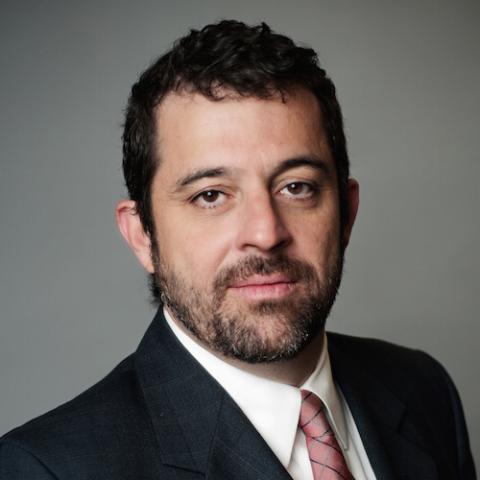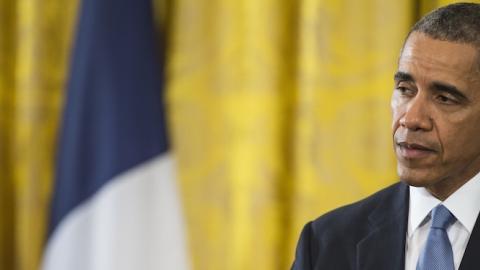Over a year ago, President Barack Obama ordered a military campaign against the Islamic State (a.k.a. ISIS) in Iraq. He expanded it to Syria. Yet ISIS remains strong and wealthy. Its following and capabilities appear to be growing.
In his White House broadcast the day before Thanksgiving this year, Obama reaffirmed his faith in his own efforts. But after Islamist terrorists murdered 130 civilians in Paris on November 13, opponents and friends alike, here and abroad, increasingly questioned the president’s credibility. It didn’t help him that, on the very morning of the attack, he said on NBC News that ISIS was “contained.”
To be sure, not every sound strategy appears successful at all times. But ISIS in recent days has been threatening Washington, D.C., and New York City, and it is governing large areas of Syria and Iraq, running a global recruitment campaign, and conducting terrorist operations in Libya, Egypt’s Sinai Peninsula, France, and elsewhere. Even Obama’s most steadfast news-media supporters, such as CNN’s Christiane Amanpour, asked whether he realized that his anti-ISIS strategy has not been working.
Is “strategy” the right word? Is the president’s approach to ISIS actually strategic? His goal is ill-defined. His plan is not systematic or comprehensive. It lacks historical perspective and insight into the nature of the enemy and, in particular, its ideological motivation. The means committed to the task are clearly inadequate.
For perspective, recall the aftermath of the September 11, 2001, attack. President Bush ordered his team to give top priority to preventing another mass-casualty attack, wherever it might come from and whatever group might launch it. The primary goal was not to punish, but to preserve our way of life as a free and open society.
This was far more difficult than finding those responsible for 9/11 and striking them. The Bush strategy called for countering not just one terrorist group, but a vast, amorphous international network of Islamist organizations and their state and non-state supporters.
The first step was striking al-Qaeda in Afghanistan. The force the U.S. deployed wasn’t large, but it combined all kinds of power: air, sea, and land, and regular and Special Operations forces. It overthrew the Taliban regime and forced the elements of al-Qaeda to scatter.
Dispersed and on the run, they found it increasingly difficult to organize their operations. To coordinate, they had to communicate over long distances. Their communications and travel were vulnerable to detection and interdiction. They were forced to devote time and attention to playing defense rather than plotting terrorist attacks.
With President Bush’s guidance, defense officials produced a strategy based on evolving insights about how terrorist networks work. The National Defense Strategy (2005) and the National Military Strategic Plan for the War on Terrorism (2006) asked what the enemy needed to operate and survive.
To operate, Bush-administration officials concluded, the terrorists need leadership, finances, safe havens, weapons, and communications. Ultimately, however, the key to the enemy’s survival is ideological support. The ideology is crucial for recruitment and indoctrination. Ideas are the defining element of the global Islamist-extremist movement.
The immediate goal of the Bush strategy was to prevent the terrorists from operating. The ultimate goal was to destroy their movement by countering the appeal of their Islamist ideology.
The National Military Strategic Plan described a five-step process: map network nodes, identify their connections and sources of support, develop an action plan, tie the plan to metrics, and track progress.
The strategy was effective in preventing large-scale follow-on attacks against us. In the case of al-Qaeda, U.S. forces promptly killed or captured more than half of its senior leadership. The United States led worldwide efforts to curtail the flow of funds to terrorists, detect key communications, interdict operatives at borders and elsewhere, conduct maritime interdiction operations, interdict weapons supplies, and generally keep them on the defensive. It imposed variously severe costs and pressures on state sponsors of terrorism — from Iraq to Libya, Syria, and beyond.
The Bush administration crafted tough rules of engagement. It sought to protect non-combatants but didn’t allow terrorists to escape by using human shields. The U.S. also did not permit terrorists to administer territory, as ISIS is doing now.
The Obama administration’s campaign against ISIS takes bits and pieces out of the Bush strategy but lacks the vigor of a systematic approach. A clear example: Over the last year, as ISIS has been funding itself largely through oil sales, the Obama administration has refrained from destroying oil-truck convoys. Why? Because President Obama said the drivers of ISIS trucks should be deemed civilians, and his rules of engagement prohibit any harm at all to civilians, even if an operation has an important, proper military objective.
In a recent attack on a large oil-truck convoy, U.S. aircraft dropped leaflets urging the drivers to flee their trucks before the aircraft returned to drop bombs. Administration officials then boasted of how many air sorties pilots have flown against ISIS.
Over the last year, the Obama administration’s approach, half-hearted at best, has given ISIS the chance to build formidable capabilities. Not only does it control substantial territory, including large cities, but it also collects taxes, provides public services, and conducts lucrative businesses in oil, sales of antiquities, and kidnappings. It operates prisons, conducts public executions, and maintains centers for the enslavement of women and children. It can fight military engagements on multiple fronts while perpetrating terrorist attacks in multiple countries.
Obama’s key formulation — “we will degrade and ultimately destroy ISIS” — is a sign of what’s wrong. The president can achieve “degrading” by almost any amount of effort, however meager. Meanwhile, “ultimately” destroying ISIS can remain forever over the horizon, as we see from the news, daily and painfully.




















